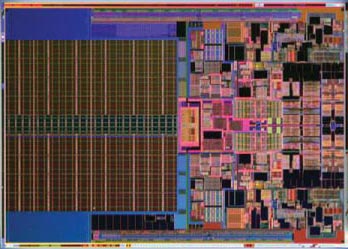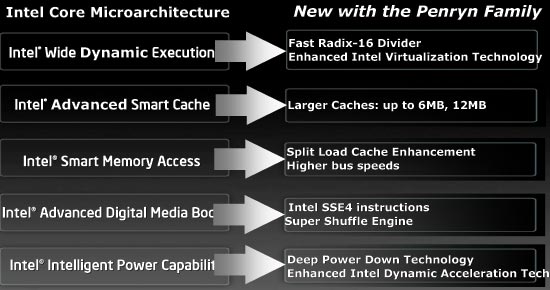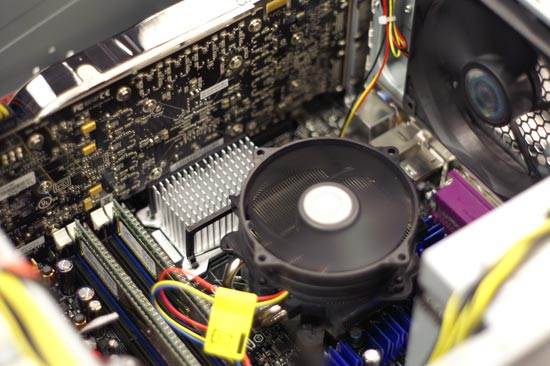Intel Penryn Performance Preview: The Fastest gets Faster
by Anand Lal Shimpi on April 18, 2007 8:00 AM EST- Posted in
- CPUs
You knew it had to be coming. A year ago Intel previewed its first Core 2 processors ahead of their release, and with Penryn due out before the end of the year the boys in blue are back again.

Penryn is still pretty early, although Intel was able to reach over 3GHz on all of the samples we tested. Not surprisingly, the number of benchmarks we were able to run was quite limited. Intel also provided us with a handful of its own test results demonstrated at IDF Beijing which we have reproduced here as well.

Penryn in action
As a recap, Penryn is the 45nm micro-architectural update to Intel's current Core 2 processors. The slide below shows most of the improvements to Penryn:

A faster divider and super shuffle engine both improve IPC in very specific applications. As we mentioned in our IDF day 1 coverage, faster FSB speeds appear to be reserved for Penryn based Xeon processors at this point as desktop Penryn cores will use a 1333MHz FSB. Penryn takes the total amount of L2 cache up to 6MB per two cores, giving the quad core Penryn chips a total of 12MB of on-die L2 cache. Penryn also has improved power management technologies, but only for mobile Penryn chips.

Penryn up and running










66 Comments
View All Comments
OcHungry - Thursday, April 19, 2007 - link
AMD's 65nm K10 will beat Intel's 45nm Penryn by 20%, my prediction.TA152H - Thursday, April 19, 2007 - link
You picking the Cubs to win the World Series?Thatguy97 - Thursday, June 18, 2015 - link
lol funny after 8 yearsKougar - Thursday, April 19, 2007 - link
Is there any info whatsoever regarding QuadCore pricing for the desktop with Kentsfield's successor? It would be very helpful to know if there might be a version of Yorkfield matching the $266 Q6600 price tag come next January... :)theprodigalrebel - Wednesday, April 18, 2007 - link
The Yorkfield-Kentsfield comparison looks correct.In the CPU-only Test, Yorkfield scores 887 points more (4957 vs 4070)
In the Overall Test, Yorkfield scores 840 points more (11963 vs 11123)
But the Yorkfield-Wolfdare scores look off...
In the CPU-only Test, Yorkfield scores 1896 points more than Wolfdale. (4957 vs 3061)
In the Overall Test, Yorkfield only scores 948 points more than Wolfdale. (11964 vs 11015)
I'm guessing the Wolfdale Overall Score should read 10015?
Shintai - Thursday, April 19, 2007 - link
Because 3Dmark score aint calculated like that.Check this.
http://www.thg.ru/graphic/3dmark06/images/3dmarkca...">http://www.thg.ru/graphic/3dmark06/images/3dmarkca...
And to add alittle fun:
http://img374.imageshack.us/img374/5569/654545fd7....">http://img374.imageshack.us/img374/5569/654545fd7....
If you take a E6600 CPU, and pair it with an inifity super performing GPU. Your score couldnt be over 35000.
Same reason, just the other way. On why the score doesnt increase with the same value.
kilkennycat - Wednesday, April 18, 2007 - link
I agree totally with the last sentence of this article. A Barcelona series of Penryn-like demonstrations and tests is many months overdue. Has AMD got serious design problems, or does the "emperor really have no clothes" with respect to Barcelona's performance ?Any hope of AMD recovering development costs with premium prices on the Barcelona family will be quashed if Intel chooses to counter with early release of Penryn-family CPUs and simultaneously undercut the AMD prices. Time to consider selling AMD stock short again?
archcommus - Wednesday, April 18, 2007 - link
I fear that AMD has not released early benches because the performance is not what they're hoping for compared to what Intel is giving out. Intel is being boastful and giving out lots of info because they know what they have is good. If AMD had a really strong competitor they'd be doing the same, unless they're really trying to surprise Intel here, which of course would be great.I have no doubt Barcelona will be released on schedule, and I'm sure it'll outperform all Conroe setups, however I feel fairly certain that Penryn will outdo it and probably only a few months after.
Sigh...
redbone75 - Wednesday, April 18, 2007 - link
That's what I'm thinking as well. Remember back when AMD was about to release the Athlon 64 they would make all kinds of cocky comments about Intel's chips, even after purposefully delaying it a few times even though they could have released it earlier? It's because they knew what they had was going to kick some serious butt. It's not the same AMD now, and that should be cause for concern AMD supporters, unless what we're seeing is a new Intel that is now open about everything and a new AMD that is like the old Intel.TA152H - Wednesday, April 18, 2007 - link
Actually, AMD did toss out some numbers for people a few weeks ago, although they seemed inflated.It could be that the processor is clocking fairly low right now, with the 65nm manufacturing much newer to them than for Intel. Keep in mind, AMD's fastest parts for the Athlon 64, are 90nm still for now, so that indicates they don't have a great handle on 65nm right now, and of course the next processor is only being made on that. It might be more an indication of their manufacturing ability, or lack thereof, than an indictment against the processor.
That's really the crux of the problem for AMD. The P8 isn't a terribly advanced processor, much less so than the technological marvel P7, but it works much better. AMD wouldn't have terribly difficult time matching the technology in it, and probably will. But, they are always trailing in manufacturing technology and there isn't an easy way to match it. It's a big advantage for Intel too, and one that doesn't seem to be going away.
It might be, and probably will be, the Intel processors are superior for the desktop, and AMD for the servers where you have multiple sockets. It could easily come down to the design decision with regards to the location of the memory controller and the use of an FSB instead of point to point. AMD pays the price for it with one socket, Intel with multiple. Is there any mystery why AMD was showing off their server products and benchmarks, and not so forthcoming with desktop parts?
Either way, Intel is going down the same road with Nehalem although on 32nm the tradeoffs might be a lot for single socket computers.